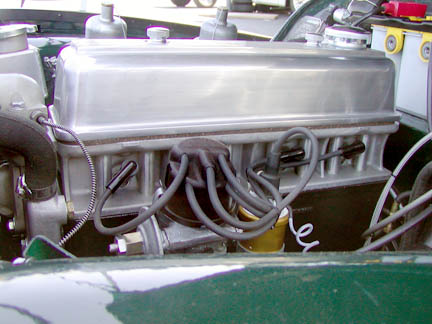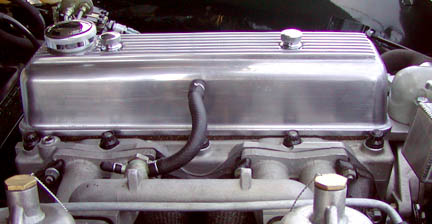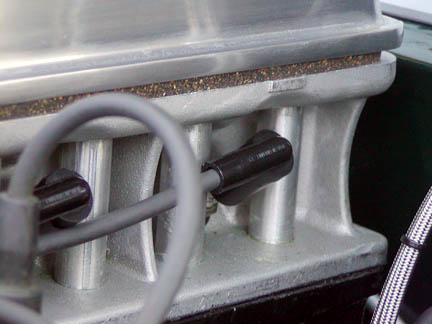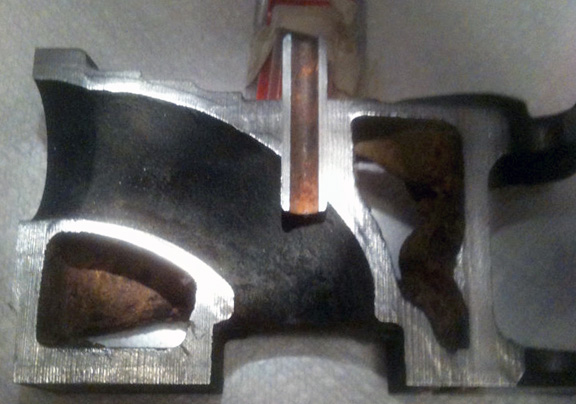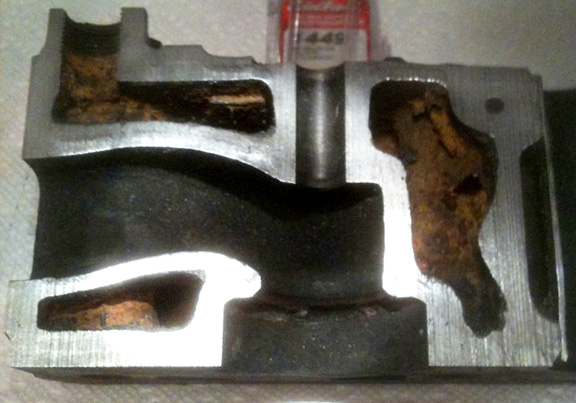
LINKS TO FEATURED PAGES:
![]() TRIUMPH Contents
page > FAQ Contents > Getting
ahead
TRIUMPH Contents
page > FAQ Contents > Getting
ahead
|
QUESTION - I have read that there were several variations of heads available for the Triumph TR2 through 4A. How do I tell one Triumph head from another?
ANSWER - The head used on the Triumph TR2 through TR4A underwent a series of improvements over time. All versions can be identified with the head on the engine except for telling the two low port heads apart and for the very first engines that came with 86mm pistons. If you plan to modify a head for additional power obtain a copy of the Triumph Competition Manual by Kas Kastner and read the section on heads before doing anything. An unshaved high port Triumph head is 3.330" tall. Measure the height of your head and subtract it from 3.33 to determine how much metal has been previously removed. When the head casting was changed to include a diagonal flat section on the underside of the lower thermostat housing the thickness of metal between the bottom of the head and the internal water passages was increased. This made the head less susceptible to cracking under thermal stress and allows the head to be shaved more for higher compression. Don't forget the thinner you shave the head the more likely it is to crack. Ken sugested 0.060 off the head and a thin head gasket as being the maximum for street use using pump premium gas. Note if you are racing and using racing fuel, Uncle Jac considered 0.130 to 0.150 "normal" to mill a TR4 head (TR3 heads with rounded lower theromostat housing has less metal at the bottom ahd should not be milled beyond 0.06). 0.190 to be where it started to get dangerous being too close to the water jacket. That said, there is some variability from head to head on where the internal water passages are. The tinner the metal between the water jacket and bottom of the head the more likely the head will crack under use. In general, the factory has done a very good job improving the head intake over time. The exhaust is the bottleneck to maximum flow. The valves are close together but there is space to add a slightly larger exhaust valve. If you feel a need to polish head passages and match manifold openings to head openings you can get the best return by doing it to the exhaust side. Here is what I have identified so far. The bulk of the data in the chart below is a result of me measuring 40+ cylinder heads in a British car wrecking yard. There is always the possibility that a head version was not represented in my sample. Do not take the engine number data as absolutes. The factory used whatever was in the shop. After purchase, head replacements were made with whatever was available to the mechanic. If you have any additional information that can help sort and identify the versions of heads used, please .
* Chamfer is located on the bottom of the head at the edge of each combustion chamber opposite the spark plug hole. Figure 1 - Low port head The low port head is recognizable by it's rectangular or boxy shape. The Le Man's had reportedly has raised bosses around the cylinder head bolt holes.
Figure 2 - Early high port head The intake ports have been moved up and enlarged to 1-1/2 inch diameter for better air flow. A 1-5/8th dia ball mill was inserted into the head intake passages about 1/4" to assure that the production intake manifold ports lined up with the production head intake ports. When you measure the intake passages at the head opening, they measure 1-5/8ths inch diameter.
Figure 3 - Late TR3A head This late head is recognizable by the diagonal slant on the underside of the lower thermostat housing. This eliminated a possible interference fit with the water pump housing after the head was shaved. There is also more metal between the bottom of the head and the water jacket. This made the head less apt to crack and allowed more metal to be removed to raise the compression ratio. NOTE: heads with this casting and chamfers for 86mm pistons are known to exist. This seems to be a very rare version.
Figure 4 - TR4 head This head style was used on late TR3A & B cars that came from the factory with with 86mm pistons. It is recognizable by the chamfer on the side of the combustion chamber and by the raised flat surface between the number 1 and number 2 intake ports. There may or may not be a serial number stamped on this surface. There is no correlation between head numbers and engine numbers. Early heads still had the intake ports ball milled to 1-5/8ths dia for the first 1/4 inch to assure that the production intake manifold ports lined up with the production head intake ports. The ball mill was eliminated in the last version of the head. This eliminated the slight turbulence at the manifold to head mating area, allowing for a higher velocity of the air fuel mixture at low and mid range. These heads measure 1-1/2 inch diameter at the surface. The late version of this head had aluminium push rod tubes fitted to the head to provide a better oil seal. All previous heads had steel tubes pressed into the head.
Limited run Competition headThe Triumph competition department had a small run of special high compression heads made. Here is a description by Kas Kastner "I had a series of cylinder heads made wherein they scrubbed the top of the internal cores about 1/8" so that the stock machining gave a 12.5 to 1 compression ratio. Then with the cutting and grinding I would just mill a little more more to get my 12.25 ( ideal) . This left the total thickness almost stock therefore giving the material needed around the combustion cambers on the squish area side." From Greg Solo:
From kas Kastner:
Cylinder heads with elongated head bolt holes
Reproduction cylinder headsNew reproduction cylinder heads have been available since the early 2000's. There are both cast iron and aluminum ones available. I have not yet been able to take measurements on any yet but they appear to be based upon the last TR4A design. There was not number stamped on the raised flat area over the number one intake passage on the aluminum head I saw. A lack of a number stamped there may be the diagnostic for reproduction cast iron heads. More later when I get a chance to examine the new heads. Pictures of the aluminum head:
Standard Vanguard head
TR4 cylinder port cross sections:Photos by Jim Gray
I just HAD to add this from an e-mail I received! "What a fine bit of cylinder head information you have provided the TR people on your site. Congratulations. Kas Kastner" Return to the FAQ contents Return to the page top
|
|
||||||||||||||||||||||||||||||||||||||||||||||||||||||||||||||||||||||||||||||||||||||||||||||||||||||||||||||||||||||||||||||||
© 1997 - 2017 TeriAnn Wakeman. All rights reserved.





